Neil Sharpson's Blog, page 12
January 25, 2023
My next novel is now available for pre-order!
Barnes and Noble are currently running a promotion for 25% off on all books being released in 2023 and guess who’s got one of those?
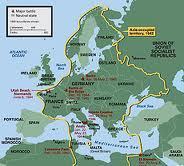 “Oh, more book schilling. How we’ve missed it.”
“Oh, more book schilling. How we’ve missed it.”Quiet you.
Yes, my sophomore effort Knock Knock Open Wide is being released September 26th, in good time for Halloween. Per Barnes and Noble:
“Knock Knock, Open Wide weaves horror and Celtic myth into a terrifying, heartbreaking supernatural tale of fractured family bonds, the secrets we carry, and the veiled forces that guide Irish life.
Driving home late one night, Etain Larkin finds a corpse on a pitch-black country road deep in the Irish countryside. She takes the corpse to a remote farmhouse. So begins a night of unspeakable horror that will take her to the very brink of sanity.
She will never speak of it again.
Two decades later, Betty Fitzpatrick, newly arrived at college in Dublin, has already fallen in love with the drama society, and the beautiful but troubled Ashling Mallen. As their relationship blossoms, Ashling goes to great lengths to keep Betty away from her family, especially her alcoholic mother, Etain.
As their relationship blossoms, Betty learns her lover’s terrifying family history, and Ashling’s secret obsession. Ashling has become convinced that the horrors inflicted on her family are connected to a seemingly innocent children’s TV show. Everyone in Ireland watched this show in their youth, but Ash soon discovers that no one remembers it quite the same way. And only Ashling seems to remember its star: a small black goat puppet who lives in a box and only comes out if you don’t behave. They say he’s never come out.
Almost never.
When the door between the known and unknown opens, it can never close again.“
My own experiences with Rimini Riddle may have influenced the creation, who can say? Anyway, you can preorder it from Barnes and Noble HERE and if you use the code PREORDER25 you’ll get a stonking 25% off the price. Money out of my children’s mouths, but what do you care?
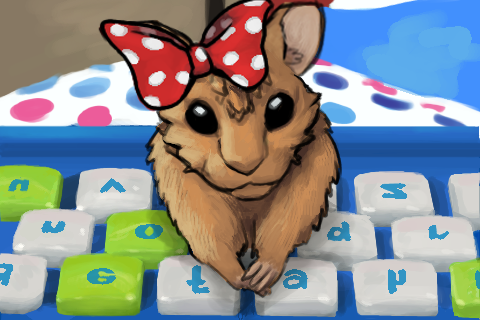 “Papa! Papa, we are ever so hungry!”
“Papa! Papa, we are ever so hungry!”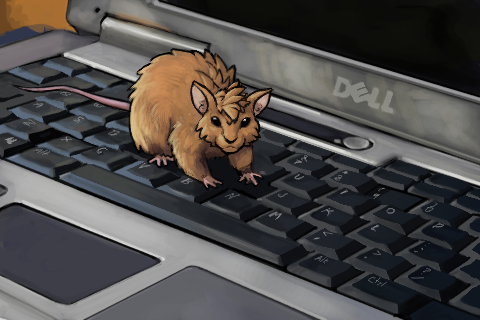 “Forgive me, child. But we must starve that Barnes and Noble may give their valued customers great savings!”
“Forgive me, child. But we must starve that Barnes and Noble may give their valued customers great savings!” “Then I must be brave, Papa. For Barnes and Noble!” *cough cough*
“Then I must be brave, Papa. For Barnes and Noble!” *cough cough*
January 24, 2023
Later Bat time, later Bat channel
Hi folks, really sorry but the Batman and Robin review is going to be delayed until next week. See, I forgot that this was the week I had a book deadline to meet, a TV proposal to submit, a driving test to take and everyone in my family was going to get sick with something. I didn’t plan the last one, but given the last few years that’s really on me.
Anyway, the review will go up February 2nd. Thanks as always for your patience and understanding.
January 12, 2023
“When did we become the joke?”
Before we begin, please take a look at these quotes:
“So one of the things that surprised me about this movie on re-watching was that it is much better than I remembered, or at the very least far more interesting. Thor exists in a much richer emotional universe than the two Iron Man movies or Hulk.”
“Something that I don’t think gets talked about when it comes to [Thor 2] is just how gorgeous it is. Seriously, the art design in this is just jaw dropping, it is hands down the best looking picture in the MCU.”
“A thought occurred to me as I watched Thor and the Revengers speeding towards a giant wormhole called the devil’s anus while blasting spaceships with lasers while Mark Mothersbaugh’s awesome techno score rippled in the background: is this movie the greatest thing ever? Yes. Yes it is.”
“Wow” you might ask. “What pathetic, gushing, blinkered, Thor-fanboy said THAT?”
“Um, me” I reply.
“Oh. Well, this is awkward” you might answer.
“Yeah. Yeah, maybe think before you say something really hurtful” I sob.
Sorry, feeling a bit emotional today. I put those quotes above to give some context. If there’s an internet reviewer who’s been as unstintingly positive to the Thor series as me I am unfamiliar with their work. I have gone to bat for this series again and again. I made Thor my highest ranked of the Phase 1 origin movies. I made Ragnarok my number one movie of the entire MCU. I HAD NICE THINGS TO SAY ABOUT THE DARK WORLD.
So when I say that Love and Thunder is not only the worst Thor movie but the worst movie in this entire 30 film franchise, I hope you understand that this is a big deal. Something that I loved has betrayed me and left me angry, appalled and ready for revenge.
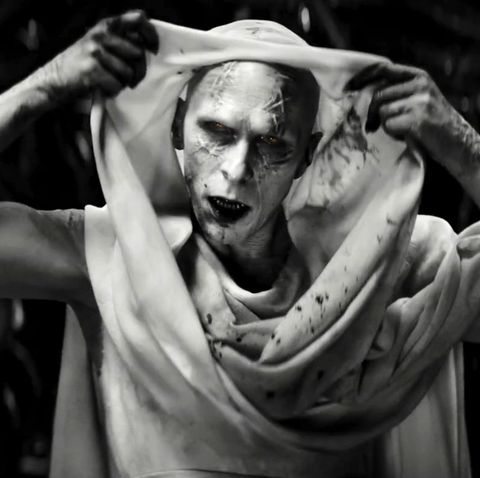 “See? This guy gets it.”
“See? This guy gets it.”There is so much I hate about this movie: The cringey dialogue, the nonsensical plot, the cheap chintziness, the My-Little-Pony Lunchbox Aesthetic, the mixture of smug emotional insincerity and saccharine, hock-inducing sentimentality. It’s the movie equivalent of a tall glass of Mabel Juice.

And you might say, “well wasn’t Ragnarok also a brightly coloured irreverent comedy? Are they really so different?” To which I reply “Some Like it Hot and White Chicks are both comedies revolving around cross-dressing, it doesn’t make them equally good” to which you reply “I’m an obvious bad faith strawman you just created to make your point, what do you want from me?”
Okay fine. I can explain pretty much everything wrong with Thor 4 in one scene. Here’s the context. Thor has found the Lady Sif, one of his oldest comrades in arms, dying on an icy battlefield. Let’s watch!
THOR: I’m gonna get you home.
SIF: No! Leave me here. I want to die a warrior’s death. On the battlefield. In battle. And then I can claim my place in Valhalla.
THOR: Oh, I hate to break it to you, but for a warrior to get into Valhalla, you have to die in the battle. You survived.
SIF: Oh, shit.
Now, the problem is not the joke. The joke is perfectly fine. Solid on the page, with the potential to be a howler with the proper delivery. The problem is this. Imagine a dear friend is dying in your arms. Is “Oh, I hate to break it to you” the kind of thing you might realistically find yourself saying? Of course not. That’s a “you may not be able to redeem that voucher” kind of phrase, not a “my dear friend is dying and may miss out on her eternal reward” kind of phrase. This is the kind of writing you get in a sketch comedy, where the joke is always prioritised over the characters. And there’s nothing wrong with that in a sketch. But we know Thor, we’ve followed him across seven movies and this mildly concerned reaction to Sif’s predicament makes the character seem absolutely psychotic. And it’s an easy fix! Here:
THOR: I’m gonna get you home!
SIF: No! Leave me here. I want to die a warrior’s death.
THOR: Sif listen to me!
SIF: On the battlefield.
THOR: No…
SIF: In battle.
THOR: Sif please…
SIF: And then I can claim my place in Valhalla.
THOR: SIF!
SIF: What!?
THOR: (desperately pleading) Sif for a warrior to get into Valhalla, you have to die in the battle. You survived.
SIF: Oh, shit.
See? The joke remains perfectly intact, and Thor is now acting in a way that feels emotionally true to the character. And this is the big, glaring difference between Ragnarok and Love and Thunder. Ragnarok built jokes around characters acting consistently and believably, and Love and Thunder builds its jokes and then bends and breaks its characters trying to fit them in.
The movie opens with an alien named Gorr played by Christian Bale as the sole redeeming element of this whole mess. He travels through a parched desert with his daughter…Love. Oh shit, that’s actually her name. That’s why it’s called…fuck. That’s terrible.
Gorr desperately prays to his god Rapu for deliverance but to no avail and Gorr has to watch as his innocent daughter dies of thirst in his arms.
Sooooo…about that tone problem. Love and Thunder deals with some incredibly dark subject matter; cancer, loss of faith, child abduction and attempted murder. We even see the onscreen death of a child which has been a major Hollywood taboo since the earliest days of film. And yet, so much of the movie is just so fucking “lol nothing matters” that it becomes really gross. And let me clarify, some of my favourite movies are comedies with very dark subject matter. Hell, my favourite comedy is Death of Stalin. But, how can I put this? Taika Waititi is no Armando Ianucci. And I’m starting to think he never was.
Anyway, broken and distraught, Gorr comes to an oasis where he finds Rapu celebrating with some of his fellow gods for having defeated a warrior who was wielding the Necro Sword, a cursed weapon that can kill gods. He then mocks Gorr for expecting his gods to actually help him or his daughter. While the dude is literally a foot away from the only weapon in the universe that can kill him. So Gorr, understandably, kills Rapu and decides to do a full Kratos on every deity in the universe.
So here’s what I think needs to be fixed here. Firstly, this sequence needed to be longer. The ease with which Gorr wanders into Rapu’s domain and just finds the Necro Sword is so damned contrived and makes this whole planet feel roughly the size of a city park. Secondly, this is Rapu.

If we’re supposed to invest in Gorr’s turn to murderous misotheism and feel that he’s at least somewhat justified then it’s not enough for Rapu to be a ridiculous asshole. He should be truly vile. Viscerally repellent. The idea that got lodged in my head is that Gorr envisions Rapu as a beautiful colourful tree frog only to finally meet him and discover a grotesque, corpulent, venomous toad.
Prologue over, we finally see our main character.
 “Hey man.”
“Hey man.”I loved Korg in Ragnarok. I think everyone did. But if you took my Korg-love and your Korg-love and everyone else’s in the entire world and put it all together, it would not be as much love for Korg as Taika Waititi evidently has. Korg is our narrator and has a vastly expanded role without really being relevant to the main story and I just got sick of this guy. Even a great joke becomes torture after the tenth telling.
So Korg gives us the backstory of the Space Viking aka The God of Thunder aka Thor Odinson aka this is not really a joke in the conventional sense but if we drag it out long enough the audience might give a mild chuckle of bemusement. He recounts how Thor lost his parents, his brother (three times), his closest friends, his kingdom and his mental health before joining up with the Guardians of the Galaxy and going on space adventures. But, according to Korg, it was the loss of Jane Foster between Dark World and Ragnarok that really got him in the giblets and he’s sworn off love forever. Oh yeah, if you thought that the Thor/Jane Foster relationship was a basically harmless but ultimately inconsequential fling that was rightly dropped from Ragnarok YOU HAVE NO SOUL. This was the greatest love story of all time and hugely important to Thor’s character and we have the retroactive continuity to prove it!
Okay, so Star Lord and Mantis come to get Thor to join their battle against the Booskans, a race of alien marauders who look like the Fireys from Labyrinth.
We get a bafflingly stupid line of dialogue where Rocket complains that Thor said they were going on holiday and Thor points out the beautiful scenery including “the three suns of Saturn”. And that is what he says. I checked the subtitles. And then I went online and found people asking how many suns Saturn has.
 Not really a “This movie is bad” point. More a “we’re fucked as a species” point.
Not really a “This movie is bad” point. More a “we’re fucked as a species” point.This leads into a battle scene between Thor and the Booskans set to “Welcome to the Jungle” by Guns and Roses. It’s a fairly transparent attempt to recreate the sheer metal awesomeness of the “Immigrant Song” sequence that opened Ragnarok. It fails, obviously, because Welcome to the Jungle isn’t worthy of carrying Immigrant’s Song luggage and it’s a shallow re-tread that doesn’t even have a rocket powered dragon, of all the nerve. That said…it’s still probably my second favourite part of the whole movie. The Booskans are a really fun bit of design and Chris Hemsworth looks like he’s having a great time so yeah, I’ll give it a passing grade. Anyway, Thor defeats the Booskans but accidentally destroys the glass temple that he was supposed to be defending. In thanks/punishment, the aliens whose temple it was gift him two giant screaming goats.
 Oh NOW we care about mythological accuracy?
Oh NOW we care about mythological accuracy?Meanwhile, back on Earth Jane Foster is quirkily dying of cancer. In between chemo/gal pal sessions with D’Arcy she sends her blood results off to Erik Selvig so we can get a completely baffling cameo.
 “Jane. For the last time. I’ve a physicist. Stop sending me your cancer blood. It’s creeping me out.”
“Jane. For the last time. I’ve a physicist. Stop sending me your cancer blood. It’s creeping me out.”Out of options, Jane decides to head to New Asgard which has, under the rule of King Valkyrie, become a corporatised theme park presenting a safe, blandly Americanised version of Norse mythology and oh Christ, I think the movie is trying to be self aware.
 “See, if I know I suck you can’t say that I…”
“See, if I know I suck you can’t say that I…” “You SUCK!”
“You SUCK!”Yeah, the Space Jam 2 defence. Not going to fly here. Also, while I feel this is just going to be tea-bagging a beehive, why exactly is Valkyrie the “king” of Asgard again? I mean, she doesn’t identify as male. And we’ve seen TWO Queens of Asgard before now so it’s not like the term is gender neutral in this context. Is the implication that Valkyrie has to be a king because she’s just that badass? Because kings are just better than queens? For some reason? Is that the implication? Because that’s a hell of a fucking implication.
Anyway, this whole sequence shows just how brutally this movie will massacre any sense of coherent and consistent world-building for a cheap joke.
 In context, this is like opening a restaurant that uses Hitler’s moustache as its logo. In Tel Aviv.
In context, this is like opening a restaurant that uses Hitler’s moustache as its logo. In Tel Aviv.Thor gets a message from Lady Sif, we get that scene I described earlier and Thor races to Asgard to stop Gorr because apparently he seeks the extinction of the gods. So, I guess this is as good a time as any to ask this.
What ARE the Asgardians? What the actual fuck are they?
Are they aliens?
Are they gods?
Are they pretty much just regular humans?
Are they super-powered?
Are they mortal?
Are they immortal?
Are they just incredibly technologically advanced or do they wield actual magic?
The movie just doesn’t seem to know or care. And no, this is not a problem limited to Thor 4, the MCU has always played pretty loosey goosey with them but it’s here that the sheer unwillingness to pick a damn lane really starts to stick in my craw.
Thor arrives in New Asgard where Gorr is attacking with an army of shadowy monsters called *checks notes* the “shadow monsters” who proceed to abduct all the children in New Asgard. Okay. Put this off long enough. Let’s discuss Gorr (short for Gorr Blimey, what a mess).

The Thor series is the fucking Kingda Ka of villain quality. The highs (Loki, Hela, The Grandmaster, Skurge, Topaz) are so very, very high. But the lows (Malekith and now Gorr), man are they low. And weirdly, they’re both played by two of my favourite actors in deathly pale makeup. Gorr, however, is even more infuriating than Malekith. Malekith was just inert and dull. But Gorr had the potential to be absolutely phenomenal as a villain, maybe an MCU GOAT. Bale is actually doing Trojan work here and there are parts of Gorr’s story that absolutely work but the writing scuppers this character to his very core. I’m not the first to point this out, I know, and you probably already know exactly what I’m going to say but to be clear; Gorr’s plan is to abduct New Asgard’s children and bring them to the Gates of Eternity, thereby luring Thor who will obviously come and rescue them. Then, Gorr plans to use Thor’s axe to open the Gates, which will grant him an audience with Eternity who is, let’s not split hairs, a god, who he plans to ask to annihilate all the gods in existence. The problem is not that the plan doesn’t make sense, it hangs together in a nutty, supervillain plot kinda way. The problem is that it completely undercuts the single most important defining element of Gorr’s character.
Gorr is a deicidal misotheist who believes that all gods are as selfish, cruel and uncaring as Rapu was. But his very plan relies of Thor being good and selfless, and Eternity being willing to almost literally answer his prayer. This is is like if….fuck, I dunno. Scar was introduced in The Lion King and then spent the rest of the movie ensuring that Mufasa stayed on the throne.
The movie also repeats The Dark World’s blunder of having a villain who has no personal interest or relationship with Thor outside of getting his hands on a Maguffin. And this is particularly galling because there was so much potential here for a very compelling, deeply personal antagonist for Thor.
Look, many (many, far too many) people have awful experiences with religion that results in them losing their faith. And when such people meet others who had a different, more positive experience with their own faith traditions they often react badly. Because it can be easier to believe that all religion is equally bad than, no, you were just dealt a really shitty hand. And then it becomes necessary for their sense of identity to try and dismantle the beliefs of others even if those beliefs are actively beneficial to the people who hold them, becoming aggressively evangelical in their atheism (and sub-optimal in their ability to appreciate irony).
So picture this. Remember Prince Thor from the first movie? That callow, selfish dude-bro. Imagine if he had an encounter with Gorr long before he came to Midgard. Maybe Gorr was questing for the Necro Sword but hadn’t found it yet. And young Thor pretty much re-affirms everything that Gorr has come to believe about the gods of the universe. And then, years later, Gorr is doing his murder rampage and he finds a planet where the people are giving thanks to Thor for saving them from some menace or other. And Gorr just can’t believe it. “Thor? Thor?! That asshole!?” And so, because he thinks he knows Thor better than anyone, he makes it his personal mission to prove to the universe that Thor is just as bad as any other god, if not worse. Now, you’ve got personal investments, you’ve got personal stakes and, you have the emotional investment of the audience as well. Because of course, we know Thor better than anyone. We’ve followed his growth from callow wastrel to true hero over eight movies now and we have a vested stake in seeing Gorr proved wrong.
I don’t want to shit on the character completely. The makeup and effects work are fucking phenomenal and Gorr is at least scary. He is a genuinely creepy dude. Bale plays two versions of the character, stoic, grieving father and creepy cockney Meth-head Voldermort and they don’t make a lick of sense as the same guy but they are individually very good performances. Such a goddamn waste.
Anyway, in the middle of the battle Thor sees a familiar figure wielding a familiar hammer and is stunned to see Jane, with Thor powers. So stunned in fact, it activates his rarely seen “shitty helmet manifestation” power.
 This is unused concept art for a live-action Bananaman movie and I don’t care about your “FACTS”.
This is unused concept art for a live-action Bananaman movie and I don’t care about your “FACTS”.Gorr abducts the children and am-scrays and we now enter probably the most excruciating part of the whole film, the stretch where that tone problem becomes unignorable.
There’s just this endless parade of dumb rom-com schtick; Thor’s butthurt that Jane and Mjolnir are now an item, Storm-breaker is jealous (neither have been given the slightest hint of being sentient in previous movies lol nothing matters). Valkyrie and Korg play the sassy gay best friends. And all the while, DOZENS OF CHILDREN HAVE BEEN AMBER ALERTED BY A FUCKING CENOBITE.
 No rush.
No rush.Thor tells the gang they have to travel to Omnipotence City to consult with the other gods of the universe. We get a scene where Jane goes to the bathroom and releases the hammer (not a euphemism) and we see her in her actual, cancer ravished state. We get a very, very generic “dying Mom” flashback where we see that Jane’s mother also died of cancer and told her to never stop fighting. And then Valkyrie shows up at her door and starts pulling weapons out of literally nowhere like Garfield the fucking cat. This movie has more clashing tones than a paint catalogue. Speaking of:
At Omnipotence City Thor meets Zeus played by Russell Crowe playing my elderly Greek uncle (he’s actually a lot of fun, I like Crowe in this part). And it’s here where the movie gets weirdly horny. With repeated references to the gods having orgies and generous helpings of Chris Hemsworth’s majestic buttocks. Now, as I told the gimp-haram only the other day, I’m no prude but this tone seems weirdly at odds with a movie that ends with a superhero giving a load of small children super powers so they can fight monsters. I mean, that climax would suggest (to me at at least) a movie heavily geared at small children. In which case, maybe dial down the Animal House shenanigans?
Well anyway, not only does Zeus refuse to help against Gorr, he tries to take the gang prisoner to stop them revealing Omnipotence City’s location. Thor stabs Zeus through the chest with his own thunder bolt and they escape to track Gorr into the shadow realm on their own. Thor tells Jane he’s still in love with her, Jane tells him she has stage four cancer, they make out and…this, just doesn’t work. The performances aren’t working, the dialogue isn’t clicking, none of this feels earned, it’s just a mess.
Okay, let me be positive for a minute. the whole sequence in the Shadow Realm is pretty goddamn cool.

The movie does a reverse “Wizard of Oz” and switches from a garish colour palette to stark black and white with the exception of the magical weapons. The battle takes place on a kind of mini planet and all in all it’s very distinct and atmospheric and cool golf clap, golf clap.
Jane sees what the Wikipedia recap for the movie calls “ancient drawings” depicting Stormbreaker being used to open the gates of Eternity. Of course, since Stormbreaker was only created in Infinity War the very earliest those drawings could have been made is 2018 which…okay, yeah, I guess that would make them ancient.
 “Fucking pandemic, man. What is time?”
“Fucking pandemic, man. What is time?”Realising that it is a SNEAKY TRAP she throws Stormbreaker into space and Gorr ambushes them and threatens to kill Jane unless Thor calls the axe. This whole sequence is bafflingly better than the rest of this movie. It looks greats, it sounds great, the music is atmospheric, the visuals are chilling, Christian Bale is skin-crawlingly terrifying. There is a version of Thor 4 where everything is on the same level of this sequence and it could be my favourite MCU movie.

Anyway, they have a big fight and Valkyrie is badly injured and they retreat back to New Asgard. Jane’s condition worsens and she has to go to hospital because, while Mjolnir allows her to function it’s not actually keeping the cancer at bay. So Jane has to make the choice between prolonging her life through chemo for the slim hope of beating the cancer or just picking up the hammer and living as much to the full in the time she has, even though it will mean her certain death. And…that’s a really heart-rending choice that many people with cancer have to make. But if you’re going to show that, the movie kinda has to be about that. For all that this movie was trumpeted as Lady Thor taking over as the new Thor…no. This is Thor classic’s story and Jane is a supporting character. And there’s just too much else going on in the rest of the movie for this to be effective.
We now get a scene where Valkyrie gives Thor Zeus’ thunderbolt and reminds him that the Gates of Eternity are at the literal centre of the universe and I’m sorry I can’t fucking even. I want you to imagine a version of Lord of the Rings where the hobbits were just popping between Mordor and the Shire between scenes. You see how that would just completely neuter any sense of epic scale for that world?
Anyway, Thor arrives as Gorr is trying to use Stormbreaker to open the gates of Eternity. Thor gives the Asgardian kids superpowers so that they can be his little army of child soldiers and they fight Gorr’s monsters. In her hospital bed Jane senses that Thor is getting his shit staved in so she summons Mjolnir, transforms into Lady Thor and travels to the centre of the FUCKING UNIVERSE in like two minutes. The two Thors destroy the Necro Sword (fun trivia, in the comics it’s actually a symbiote like Venom and Carnage) but Gorr succeeds in opening the gate and all three stand before Eternity.
 Fair’s fair. That’s fucking gorgeous.
Fair’s fair. That’s fucking gorgeous.Jane is dying so Thor tells Gorr he’s won and that he doesn’t want to fight anymore. He also suggests that instead of using his wish to destroy all the gods he could just, y’know, bring his daughter back. And Gorr’s all “ohhhhhhh yeah” but then he coughs and says “I’m dying”.

Thor offers to look after his daughter, Gorr makes the wish, he dies, Jane dies, Thor now has a daughter who he makes pancakes for because this movie ran out of script and had to hastily patch the gaps with the fan-fiction of a horny forty something Mom from Utah.
And the movie ends with Thor taking his eight year old daughter into battle to fight monsters.
 Daaaaaaw still a warcrime.
Daaaaaaw still a warcrime.***
When I reviewed Hercules way back in the Cambrian period I said it was “Aladdin, but too much”. In the same way Love and Thunder is Ragnarok shoved down your throat until you choke along with random fistfuls of a completely different, much darker movie that got mixed up in all the rush. It’s not very good. Is that coming across? IT IS NOT VERY GOOD.
Scoring
Adaptation: 04/25
A Thor movie that doesn’t feel like the comics, doesn’t feel like the previous movies and is so tonally inconsistent it somehow manages to not feel like itself. A spectacular clusterfuck.
Our Heroic Heroes: 07/25
I was a fan of Chris Hemsworth’s performance as Thor long before most of you Johnny-come-latelies which is why it’s so hard for me to report that something has gone seriously wrong. His performance here has descended into broad pantomime, like he’s playing the version of Thor that lives in the Anchorman universe.
Our Nefarious Villains: 08/25
I confess I haven’t actually read any of Gorr’s comic book appearances but I honestly think that’s irrelevant. The concept is perfectly clear and solid, and it’s been completely mishandled here. God bless Bale, he’s trying his damndest.
Our Plucky Sidekicks: 03/25
It’s genuinely impressive how many of my favourite Marvel supporting characters this movie managed to make completely unlikable.
The Stinger
Back in Omnipotence City, Zeus (who is still alive), bemoans how superheroes have replaced gods in the minds of mortals and orders his son to kill Thor. That son’s name? HERCULES.
And the audience went…
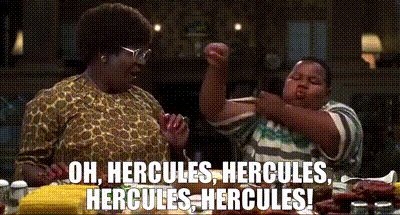
Until they start introducing X-Men and Fantastic Four characters into the main MCU, we’ve basically run out of big marquee names. I’m happy to see Hercules though, the Marvel version is actually a really fun character.
The second stinger
Jane Foster arrives in Valhalla and is greeted by Heimdall.
And the audience went
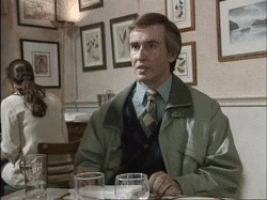
Always happy to see Idris Elba, but it really should have been Odin. Jane Foster and Heimdall never really had any meaningful relationship. To have Odin go from seeing Jane as a “goat at a banquet” to welcoming her into Valhalla as an honoured warrior would have been a much more satisfying resolution for her character. Maybe Anthony Hopkins wasn’t taking their calls.
FINAL SCORE: 22%
NEXT UPDATE: 26 January 2023
NEXT TIME: A movie called “Batman and Robin” simply cannot be bad. That’s just science.

December 24, 2022
That time of year again.
I had a conversation on the bus with Spouse of Mouse recently where I mused about what I was going to put in the end of year wrap up. “I dunno” I said. “2022 felt the first kinda “normal” year in a long time. Doesn’t feel like anything super crazy happened.”
She looked at me like I was insane.

Oh riiiiight, the thing.
My God, you can get used to anything can’t you? Yes, ignore me, I don’t even know what time is any more and it’s been that way for some…something, I don’t know what the correct term is. Anyway, after the orgy of book schilling that was 2021 the blog must have seemed very sedate this year. The new year will not be like that. Big things in the pipeline folks. We’re gonna have to call a plumber…
But in the meantime, check out this absolutely stunning cover for the Czech translation of When the Sparrow Falls from Planeta 9 publishing.

Or, as it’s called in Czechia, 2184: The Fall of the Caspian Republic. Because, as one Czech reviewer noted “who would buy a book called When the Sparrow Falls?”

Anyway, here’s what I did this year.
In 2022 I reviewed 1 Canon Disney movie, 4 MCU movies (plus Hulk), 3 X-Men movies, 3 animé, 3 live action movies, 4 non-Disney animated feature, 2 animated series and 1 Batman movie.
It was a pretty great year, honestly. After the fairly paltry showing of last year I actually managed to make some sort of dent in my review pile and I discovered plenty of new movies that I wouldn’t have seen otherwise. Best movie this year isn’t even close.
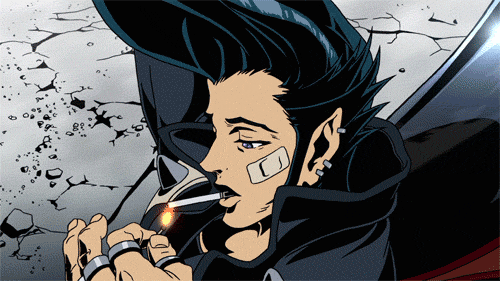
Redline reminded me of why I love animation in the first place. As for worst? Alice in Wonderland, which increasingly feels less like a movie and more like an early onset symptom.
Even if 2022 wasn’t actually a return to normality in any way, I hope it at least fooled you like it did me.
Have a wonderful, safe and happy Christmas and a great new year.
Nollaig shona daoibh go léir,
Mouse.
December 7, 2022
The Polar Express (2004)
It’s probably a testament to just how jaded I am that my first thought when watching The Polar Express was “actually, this animation isn’t half bad”. The Polar Express is notorious for being the start of Robert Zemeckis’ turn to the dark side, where one of the most respected directors of genre cinema became a professional corporate necromancer.
 Oh shit, I acknowledged its existence. Someone fetch my flail.
Oh shit, I acknowledged its existence. Someone fetch my flail.And The Polar Express was his first attempt at making an all CGI mocapped film and is infamous for being utterly, skin-crawlingly unsettling in its depiction of human characters. And yet, maybe it’s because I‘ve seen the absolute depths to which this accursed path would lead Zemeckis I found myself not minding the animation too much, for the most part at least. It just looks like a computer game cutscene. And, if I’m being scrupulously fair, there are even shots that I think are honest to God beautiful.

My, this review is trending rather positive isn’t it? I wonder if that will last.
So the movie first entered pre production in the nineties when Tom Hanks optioned the rights to The Polar Express by Chris Van Allsburg with the intention of making it into a live action film. But Zemeckis convinced him to do it in motion capture CGI, claiming that trying to do the story in live action would cost over a billion dollars. From this, we must assume that Robert Zemeckis is a filthy liar who will say or do whatever it takes to get to practice his perverse CGI occultry. How? How would it cost €1 billion dollars? A boy goes on a train to the North Pole and meets Santa Claus. That’s it. Do Santa movies typically cost the GDP of a developing nation?
 This one shot cost more than the combined wealth of all the monarchs of Europe.
This one shot cost more than the combined wealth of all the monarchs of Europe.Short of cloning your own Santa Claus with magical powers I have no idea how Zemeckis got that figure or why anyone listened to him. But I digress.
Our story begins with our boy hero who is named *checks notes* “Hero Boy”.

There are plenty of movies that would benefit from losing a character or two. This unfunny comic relief character, that love interest that goes nowhere. But The Polar Express may be the first movie I can recall seeing that would genuinely work better if the PROTAGONIST was cut. Hero Boy is not a bad character. Hero Boy is NOT a character. He has one, trait, sort of; he isn’t sure whether or not he believes in Santa Claus. Now, if a magical Christmas Themed steam engine rolled up to my house on Christmas Eve offering to take me to Santa’s workshop, I think that would settle the matter for me but this kid’s still on the fence apparently.
Anyway, Hero Boy meets the conductor played by Tom Hanks.

Now, much has been made of how creepy and unsettling the Conductor is but here’s where I’m going to have to blow your minds. Are you ready? The problem isn’t the animation. The problem is Hanks’ performance.
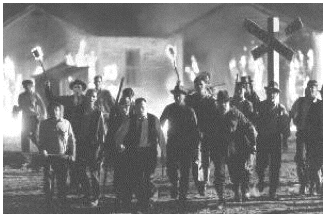 Awwwwwww, Merry Christmas guys.
Awwwwwww, Merry Christmas guys. Been too long.
I’m serious though, this is really misjudged. Hanks is clearly going for a mercurial, Wonka-esque character. The problem is, Willy Wonka is actually really menacing, but we don’t care because, with the exception of the Buckets, all the people who he might endanger are complete shits. Hanks cycles through cold indifference, manic bonhomie and furious rage and I am scared for these kids. This is not the kind of behaviour I want to see from a man who abducts children in the dead of night for a journey on his magic train WHAT DID YOU JUST TYPE MOUSE ARE YOU TRYING TO GET SENT TO JAIL?
The Conductor offers Hero Boy a seat on the train and the boy, sensibly, refuses. The Conductor shrugs and says “suit yourself”and the train begins to pull away. The boy has a last minute change of heart and climbs aboard. On the train Hero Boy meets “Spirited Girl” because the cast of this movie reads like the roster of the Legion of Superheroes circa 1962. He also meets OH SWEET JESUS IN HEAVEN.
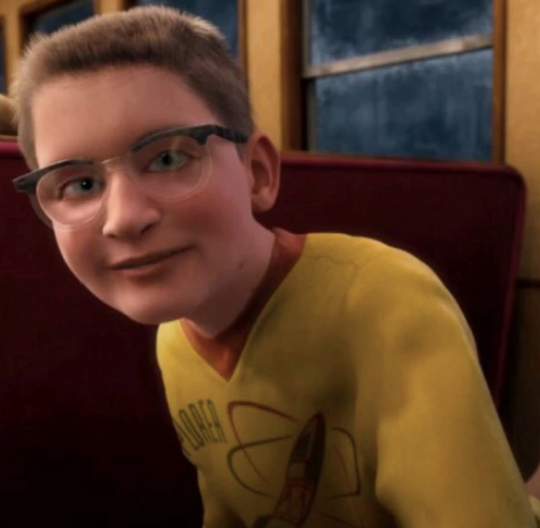
Is there anything creepier than adults playing children? This is Know-it-All Boy, voiced by Eddie Deezen and I have been damaged forever by having to endure him. Anyway, Hero Boy makes friends with Spirited Girl who is so gung-ho for Christmas the Ghost of Christmas Present would tell her to tone it down a notch.
Now, here is where my biggest problem with the movie rears its head. The Polar Express stops outside the house of another little boy named Billy. The Conductor offers Billy a seat on the train and the boy, sensibly, refuses. The Conductor shrugs and says “suit yourself”and the train begins to pull away. Billy has a last minute change of heart and chases after the train.
Now, did that sound at all familiar? Yeah, it’s pretty much a beat for beat repeat of how Hero Boy gets on the train. And Billy, unlike Hero Boy, actually has a defined personality. I mean, it’s kind of a downer, but he feels like a character in a way Hero Boy doesn’t. Hero Boy isn’t sure this whole Santa deal is on the up and up, but Billy is actually miserably depressed. He doesn’t feel this whole Christmas cheer everyone keeps going on about and worries that there’s something wrong with him. He’s genuinely a tragic figure. So my question is; why do we even need Hero Boy at all? Why not make the core relationship of the story the friendship between Spirited Girl and Billy? I guess they were going for a Spock/Kirk/McCoy thing where Hero Boy is the neutral centre between Billy’s Christmas blues and Spirited Girl’s bubbling holiday cheer but, and I say this with all due respect, Hero Boy is no James T. Kirk. He’s a charisma-less, sucking void.
Okay, Billy doesn’t want to sit with the other kids so the girl brings him a cup of hot chocolate. While she’s gone, Hero Boy notices that she left her ticket on her seat. He picks it up and the wind plucks it from his fingers and sucks it out the window. When the Conductor arrives to check tickets, the girl can’t give him hers so the Conductor says that she’ll have to come with him. And Know it All tells Hero Boy that the Conductor is going to throw her off the back of the fucking train.

Well, I mean, is it even a Christmas movie without some attempted child murder? Meanwhile, we see the ticket being blown through the mountains in a scene that just screams “how else are we supposed to justify the ticket mark-up for the 3D?” before being blown right back into the train. Hero Boy finds the ticket, and runs after friendly Mister Conductor before he can THROW THE SMALL GIRL FROM THE BACK OF THE TRAIN. He follows them onto the roof, trudging through the snow after the light from the Conductor’s lantern. Yes, I know it’s stupid, shut up, this is a part of the movie that I actually like.

Hero Boy comes across a Hobo, sitting at a campfire on the roof of a train and playing “Good King Wenceslas” on a hurdy gurdy. It’s a wonderfully atmospheric and creepy introduction to the character and the Hobo (also played by Hanks), is the one performance in this that I think really works. He’s spooky and mysterious and unsettling and he’s actually supposed to be. Which is nice. Unfortunately, the movie introduces a potentially awesome villain and then proceeds to do absolutely fuck all with him. (Personally, I’d have loved if he was secretly Krampus. We need more Krampus in our Christmas movies).
Hero Boy reaches the engine where he finds that Spirited Girl has been put in charge while the Conductor, the Engineer and the Fireman try to fix the train which is speeding out of control because we need another set-piece to justify the 3D.
Hero Boy gives the Conductor the girl’s ticket and he takes them back to their seats. You could cut out the entire sequence from Billy arriving on the the train to this moment and a first time viewer wouldn’t even notice. Nothing has changed, no characters’ arcs have been advanced. Not a good sign.
They arrive in the North Pole and the Conductor tells the kids that one of them will get the first Christmas gift of the season from Santa. Hero Boy and Spirited Girl go to the rear carriage to try to convince Billy to come along but he’s just not feeling it. Suddenly, the car gets detached from the rest of the train and goes hurtling through the streets of Santa’s company town because 3D is the future of cinema, damn the skeptics. The three kids now have to make their way through Santa’s toy factory, which consists of massive deserted spaces with all the life and cosiness of a cathedral on a bleak November night. Spirited Girl leads them as she can hear the sound of a bell ringing that Hero Boy can’t and eventually they come to the elf command centre. These are the scariest fucking elves outside of Warhammer 40k. I honestly cannot believe these were intended to be appealing.
 Thing looks like a humanoid sphinx cat.
Thing looks like a humanoid sphinx cat.They talk in these shrill Noo Yawk accents that honestly sound like they were going for “Mafia flunkey” and they’re just…wrong. They just are.
The kids pass a treadmill with presents going by and Billy sees one with his name on it and chases after. This leads to the kids going down a loooooong slide just so you know you totally weren’t conned into schilling out extra money for a meaningless gimmick (God DAMN I’m glad 3D died. Again).
They’re dumped into a massive sack of toys where they also find Know it All, who snuck into the sack to get his presents early. The sack then gets scooped up by a massive airship and find themselves hanging hundreds of feet up in the air until they’re rescued by the elves who tell them they knew they were there the whole time while cackling like little goblins. They clearly are supposed to be unsettling. But…why? Why does Robert Zemeckis hate Christmas?
Everyone’s getting ready for the sleigh to take off, and the flying reindeer are gyrating through the air like hairy antlered eels. It’s unsettling as fuck, I tell you what. Cast loose by their hideous, unnatural contortions, a bell flies loose from the reindeer’s reins. Hero Boy can’t hear it at first, but then he shakes it again and he hears the bell because he finally believes.
You know, after having ridden a magical train to the North Pole, seen the magical city there, visited Santa’s Workshop, seen the literal elves and actually fucking flying reindeer. Quite a leap of faith there.
He looks up to see Santa Claus standing behind him.
He returns the bell to him, and Santa decides that he deserves the first gift of Christmas.
 He doesn’t. Santa Claus is wrong.
He doesn’t. Santa Claus is wrong.***
Full of heart, humour, great characters and indelible songs while still managing to say something truly profound and even spiritually uplifting about the true meaning of Christmas, you really can’t go wrong with Muppet’s Christmas Carol.
Scoring
Animation: 07/20
Honestly a LOT better than I expected. Still manages to horrify here and there.
Leads: 06/20
I was sorely tempted to give this category a zero because he’s just such a NOTHING but then I remembered that I gave the kid from Mars Needs Moms a whopping three so here we are.
Villain: 08/20
The Hobo is actually pretty menacing and is introduced in a pretty effective scene but then he doesn’t really say or do anything for the rest of the film which is a bit of a flaw in your antagonist.
Supporting Characters: 03/20
I mean, are these even characters? Supporting talking props.
Music: 13/20
Alan Silvestri delivers some nice Christmassy vibes.
FINAL SCORE: 37%
NEXT UPDATE: That’s it for 2022 peeps. I’ll have my usual end of year wrap up and then I’ll see you all 12 January 2023.
NEXT TIME: Sure, Phase 4 has been pretty lacklustre but surely Thor can save us? Right? Right?!

November 23, 2022
Heavy Metal (1981)
Heavy Metal began in 1977 as an American translation of Metal Hurlant, a French science fiction fantasy magazine that featured seminal work by such legendary creators as Moebius, Enki Bilal and Jean Claude Forest and had a massive influence on the entire comic book medium because TITS.
Tits tits tits. Melons. Gazongas. Knockers. Hooters. Tatas. Jugs. Boobies. Yayas. Bosoms. Chesticles. Mazumas. Badonkadonks. Big ol’ greasy Baps.
Was there some genuinely thought provoking and visually spectacular sci-fi in its pages? Absolutely! Playboy also published plenty of great articles, what’s your point?
Heavy Metal, the 1981 anthology animated film that adapts many of the magazine’s most iconic stories, has tits. It has many tits. It has big tits and small…actually no, it only has big tits. In the ancient swamp of the pre-internet age, that really was enough. The marketing campaign could literally have been the words “CARTOON BOOBS, YA DIG?” plastered on every available surface and this movie would have been a success.
But for a jaded, modern reviewer who sees boobs once (maybe even twice) a month, it’ll take more than that. So, is there more to Heavy Metal than awesome bewbage? Let’s take a look.
Being an anthology, Heavy Metal is divided into several segments, each based on a different feature from the magazine and with different animation team. So, you know what that means!
 “It means you wasted a perfectly good choice for Shortstember.”
“It means you wasted a perfectly good choice for Shortstember.”Soft Landing
The first sequence is less an animated short than a credits sequence with ideas above its station. After the obligatory eighties portentous narration over a star-field telling us that a great evil from beyond the stars is about to yada yada yada, a space shuttle appears over a planet and disgorges a 1960 Corvette being driven by an astronaut. The Corvette then lands on the planet and drives to a house in the middle of nowhere, all to the strains of “Radar Rider” by Riggs. It’s pretty badass, and as an introduction to the film’s unique melding of ray-gun gothic and sweaty rock music it absolutely does the job. Cool fact, one of the directors of this was American-Irish animator Jimmy Murakami whose studio would later animate the original Teenage Mutant Ninja Turtles.
Grimaldi
We transition directly into our next sequence, Grimaldi, which will serve as our rather contrived framing device for the rest of the movie. The astronaut steps into his home and his young daughter runs down the stairs to greet him and ask him what he brought back from space. He tells her to come into the living room and he opens his suitcase which disgorges a glowing green ball of pure evil that reduces him to goop. The globe (which is called the Loc-Nar) corners the astronaut’s daughter and tells her that it is the sum of all evil in the universe.

The Loc-Nar says that he’s totally going to kill her but, before he does, he will demonstrate his evil by showing her several short-form narratives of wildly varying quality. These stories all involve the Loc-Nar in some way, and will show just how eeeeevil it truly is. And am I the only one who smells bullshit? We have a saying here in Ireland; if you gangsta, you ain’t gotta tell nobody you gangsta. Then again, the Loc-Nar has basically trapped this poor girl and is forcing her to watch a slideshow of every vacation it’s ever taken so yeah, that is something the manifestation of all evil would do.
Harry Canyon
“Harry Canyon” is based on The Long Tomorrow, a two part comic story illustrated by Moebius and written by legendary screenwriter Dan O’Bannon as a lark while the two men worked on Alexandro Jodorowsky’s ultimately doomed attempt to film Dune. This one, ridiculously influential comic would go on to influence…oh, pretty much every science fiction movie made after the late seventies as well as kickstarting the cyberpunk genre. What’s truly impressive about this short is how it manages to mimic Moebius’ utterly insanely detailed art-style without the animation looking like shitty ass. It’s quite an achievement. Our story begins in a decaying, crime-ridden New York in the 2030s and our hero is Harry Canyon, a gruff, balding, take-no-BS cabbie who is so used to dealing with potential thieves that he has a collection of weapons taken from guys who’ve tried to rob him. One day, a beautiful and mysterious red-head lands in his cab and Harry is pulled into an interplanetary conspiracy involving crooked businessmen and an alien ball of pure evil and also the red-head gets her boobs out for no readily apparent reason…

Yeah, that little description might strike you as a little, shall we say, familiar.
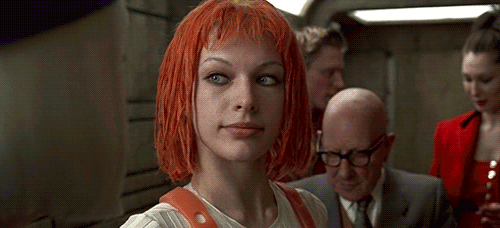
Moebius actually worked with Luc Besson on The Fifth Element, and later actually sued him for plagiarising his work…but not The Long Tomorrow. Moebius claimed that Besson had ripped off another of his works, L’Incal and ended up losing the case. I can’t help feeling that if he’d claimed that The Long Tomorrow had been Besson’s inspiration, he’d have been on much firmer ground, but what do I know? France, it’s a different planet. Anyway, the woman’s father is an archaeologist who was murdered by gangsters who were looking for his most recent discovery, the Loc-Nar. Harry takes her to a police station but can’t afford a murder investigation (I mean that literally, the cops charge $1,000 a day). So instead he takes her back to his apartment and she offers to sleep with him because he saved her life and it’s a movie in the eighties (God I hate this trope). Anyway, Harry wakes up the next morning and she’s gone. He gets threatened by cops and then gangsters who are all looking for the woman. He then gets a message by drone telling him to meet her on the Statue of Liberty. The red-head shows him the Loc-Nar and tells him that the head gangster, Revnick, has agreed to pay her for it but she wants Harry to come as backup. Harry, the old romantic that he is, tells her that he’ll do it for a fifty fifty split. She bats her eyes and tells him that he can have anything he wants and he says “Money please”.
 “I live in NEW YORK. My rent could fund the space programme.”
“I live in NEW YORK. My rent could fund the space programme.”They make the trade off and leave Revnick with the Loc-Nar, which promptly turns him into goop. As they drive off, the red-head pulls a gun on Harry and tries to double cross him which is exactly the kind of ruthless power play I’d expect from a museum curator’s daughter. Harry vaporises her with the death ray he keeps hidden in the seat of his cab for dealing with unruly fares and takes the money, musing that it was a “two-day ride with one hell of a tip”.
Back in the astronaut’s house, the Loc-Nar tell the girl that he’s chosen her because she possesses powers that she doesn’t understand and so he’s going to show her another story about someone who had powers that they didn’t…understand.
 “I AM THE LOC-NAR, MASTER OF ALL SEGUES.”
“I AM THE LOC-NAR, MASTER OF ALL SEGUES.”Den
Den tells the story of a young, nebbish teenager named David Ellis Norman (‘Den’) who finds the Loc-Nar in his back garden. He takes it to his bedroom and, during a lightning storm, he is transported to an alien world and he himself is turned into a massive, muscled warrior with a schlong the size of a Tuscan salami. There, he battles monsters and has proper sex with many beautiful ladies. It is completely juvenile but it’s saved by the narration by John Candy who invests the protagonist with the guileless, aw shucks enthusiasm of a kid who’s accidentally been locked in a toy store overnight. It’s very silly and nakedly pandering but it’s carried off with such tongue in cheek awareness that it ends up being oddly charming. The short ends with Den refusing the power of the Loc-Nar and remaining on the alien world to continue having adventures and proper sex with many beautiful ladies.
Back in the astronaut’s home the Loc-Nar tells the girl that “even when someone is strong enough to resist me, my power remains undiminished” which I’m sure is technically true. I mean, if you ask a girl out and she shoots you down, your attractiveness remains undiminished but clearly it wasn’t much to yell about in the first place. Perhaps sensing our pity, the Loc-Nar hurriedly switches to another story.
Captain Sternn
On a space station in the far future, Captain Lincoln Sternn is on trial for various and sundry awful crimes. He pleads innocent, much to his lawyer’s dismay, as Sternn is so guilty the best they can hope for is a secret burial so his grave doesn’t get desecrated. Sternn’s not worried however, as he’s got “an angle”.
 “Kif, I’m feeling the Captain’s itch.”
“Kif, I’m feeling the Captain’s itch.”Said angel is Hannover Fiste (heh), a witness for the prosecution who Sternn has bribed to give favourable testimony. Unfortunately for Sternn, Fiste has come into possession of the Loc-Nar which takes control of him and…makes him tell the truth so that Sternn will actually face justice for his actions?
Loc-Nar…do you not know what evil is? Are you…are you evilliterate?
 “SHUT UP! I TOTALLY KNOW HOW TO BE EVIL! I PUT PINEAPPLE ON PIZZA! I PARK IN THE DISABLED ZONE!”
“SHUT UP! I TOTALLY KNOW HOW TO BE EVIL! I PUT PINEAPPLE ON PIZZA! I PARK IN THE DISABLED ZONE!” “YOU HAVE NO ARMS OR LEGS!”
“YOU HAVE NO ARMS OR LEGS!”Fiste then proceeds to turn into a massive, hulking…hulk and trashes the courtroom, trying to kill Sternn. Sternn leads the monster into a corridor and then pulls a switch which opens an airlock, sucking Fiste into outer space. And that’s it, that’s the sequence.
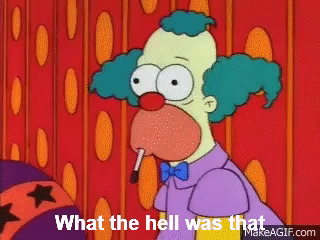
In fairness, the original comic is kind of a nothing burger too. Beautifully drawn (and the movie does a really great job of replicating the original artwork) but it’s pretty darn insubstantial.
B-17
We now come to B-17 which is the shortest sequence (if you don’t count “Soft Landing” which you obviously shouldn’t) and it is BY FAR the best one. Seriously, it’s not even close. Introduced with the title track Heavy Metal (Takin’ a Ride) we see a World War 2 era bomber flying over the Pacific. Having been shot up by enemy fire, only the pilot and co-pilot are still alive. The co-pilot sees a strange green light following the plane which is, of course, the Loc-Nar, who’s actually decided to do something evil today. The Loc-Nar reanimates the dead crew-men as gruesomely detailed zombies.

It’s a brutally effective little premise. Tiny confined space flying a mile over the ocean. Zombies. What happens next?
After a few minutes of mostly wordless, monstrously effective horror, the last surviving airman parachutes down onto a jungle island only to discover a graveyard of dozens of downed aircraft…complete with zombie crews of their own. It’s a phenomenal short. Unfortunately, we go from the movie’s high water mark to its nadir.
So Beautiful & So Dangerous
A woman, wearing the Loc-Nar as a piece of jewellery because the movie has basically given up on tying all these strands together at this point, gets abducted by stoner aliens and has sex with a robot. That’s pretty much it. It’s just weird, painfully unfunny stoner comedy mixed with gratuitous nudity.
The Loc-Nar tells the girl that he’s going to kill her because she’s the only one who could destroy him but hey, how ’bout one last vignette for the road?
Taarna
Taarna is our main feature, essentially, by far the longest section and probably the most famous what with Taarna being on the movie poster and that one South Park episode parodying it to Hell and back. The Loc-Nar finally gets of its ambiguously existent ass and crashes into a post-apocalyptic wasteland. It attracts hordes of Mad Max-esque tribesemen and coats them in green goo, turning them into savage green mutants. These mutants then wage war on all of civilization while riding giant bats and blasting Black Sabbath. It is, to quote the poet Keats, metal as fuck.

One of the cities they attack puts out a call to the Taarakians, a once proud warrior race whose numbers have dwindled to a single member; the warrior woman Taarna who spends her days flying her pterodactyl in front of gorgeous, Moebius inspired artwork.
 Look at these backgrounds, for feck’s sake.
Look at these backgrounds, for feck’s sake.Tarna prepares to rescue the city by slooooowly putting on her extremely practical battle bikini and by raising her magic sword and saying “FOR THE HONOUR OF GREYSKULL”.
 Never leave any unattended valuables around Filmation, that’s all I’ll say.
Never leave any unattended valuables around Filmation, that’s all I’ll say.Taarna then heads out to the city only to find that everyone is already dead.
 “Tragic. But I don’t see how I could possibly have gotten here quicker.”
“Tragic. But I don’t see how I could possibly have gotten here quicker.”She flies off, finds the leader of the mutants, battles him, and then she and her pterodactyl fly a kamikaze mission into the volcano, using her magic sword to destroy the Loc-Nar. Or, seeing as he’s been narrating this whole thing, at least mildly inconveniencing him.
Taarna has probably the most impressive animation in this whole thing, with gorgeous backdrops and some mighty fine flying scenes that must have been a nightmare to render by hand. The expanded length also helps the short as it allows room for the characters and world to breathe. And Taarna, for all her fanservicey design, is quite compelling as a brooding, utterly silent hero. Probably my second favourite sequence after B-17.
We then flash back to the astronaut’s house where the Loc-Nar starts to break apart because the story he was telling was so traumatic that he triggered himself. Terrified, the girl runs out just before the house explodes, presumably destroying the Loc-Nar. She runs into a field until she sees a pterodactyl waiting for her. She climbs on and flies away, turning into Taarna because apparently she was actually Taarna all along or something, I dunno.

***
Heavy Metal is pretty dated in a lot of ways. This is the kind of movie where the credits list two characters simply named “girl” and another two named “whore”. Buuuut if you can get past the dated gender politics, the gratuitous nudity, the wildly veering tone and quality there is a fascinating, weird and unique slice of animation history right here. It’s not for everyone, but I’m only slightly embarrassed to admit that it’s very much for me.
Scoring
Animation: 13/20
Really hard to judge an anthology with such wildly different animation but it averages out around here.
Leads: 11/20
Again, mixed bag.
Villain: 07/20
I’ve seen villains who tried to talk the heroes to death. I’ve never seen one who talked himself to death.
Supporting Characters: 14/20
Guys, I’ll be honest, I’m just picking numbers at random here.
Music: 15/20
Fittingly, the soundtrack rocks. Also, the incidental score by Elmer Bernstein is very effective (and keep an ear out for an early appearance of elements from the Ghostbusters soundtrack).
FINAL SCORE: 60%
NEXT UPDATE: 08 December 2022
NEXT TIME: This is the only Christmassy thing on my “to-review” pile. Is it too late to convert?

November 9, 2022
Rock and Rule (1983)
Imagine you go to a Burger King and the guy at the counter serves you with a smile, promptly brings the food to your table, thanks you kindly for your custom and wishes you a good day. Someone, in short, who doesn’t have to put nearly this much effort into their job but does it anyway because, gosh darn it, if you’re going to do a job you might as well do it well.
That’s Nelvana. Nelvana is an extremely prolific Canadian animation studio who produced basically any cartoon you saw in the eighties or nineties that wasn’t made by Disney, Hanna-Barbera, Filmation or Warner Bros. They’re probably most famous (if you’re my age, at least) for their many, many licensed animations for properties like Care Bears, Strawberry Shortcake and My Pet Monster. Nelvana were front and centre in the saccharine, corporatised swamp that was the American TV animation scene in the Reagan era. Like many of their peers, Nelvana had to make ends meet in the burger joint by cranking out barely concealed animated toy commercials. Unlike many of their peers, Nelvana actually seemed to give a damn. Their shows were, broadly speaking, better than they needed to be and demonstrated real skill and craftsmanship in their animation. There were always hints that, if given time and a budget and a premise slightly less anodyne than “Will Grumpy Bear ever get that stick out of his ass?”, Nelvana had the talent to make something truly special. And, if ever there was a time to do it, it was the early eighties.
The late seventies/early eighties were the “Warring States” period of American Feature Animation. The senile old king, Disney, had fallen from his throne and seemingly every animator who could hold a pencil was scrambling for the crown. This was the heady time when Rankin Bass, Ralph Bakshi and Don Bluth battled for control of the artform, right up until 1989 when the old king came back and was like “I’m feeling a lot better now everyone, thank you for your concern“.
But all that was in the future. Nelvana was formed in 1971 by Patrick Loubert, Clive Smith and Michael Hirsh with the stated intent of creating a Canadian Disney.
 “You fucking hoosers, eh?”
“You fucking hoosers, eh?”After several well received Christmas specials and animating literally the only part of the Star Wars Holiday Special that deserved to be spared the flame (the cartoon that introduced Boba Fett), the studio began work on their first feature length animation; Rock and Rule. It’s an obvious passion project, clearly made by a young team just bursting with talent and ambition and love for what they were doing. It’s also something that was very obviously begun without a complete script or even a set plot. It’s weird. It’s uneven. It’s a wild, uncontrolled shambling mess of eighties animation that failed when it was dumped into theatres with no marketing by a distributor that neither loved nor understood it. Which obviously means that it was made for me, Mouse, personally.
 “I shall take this movie, and raise it as my son.”
“I shall take this movie, and raise it as my son.”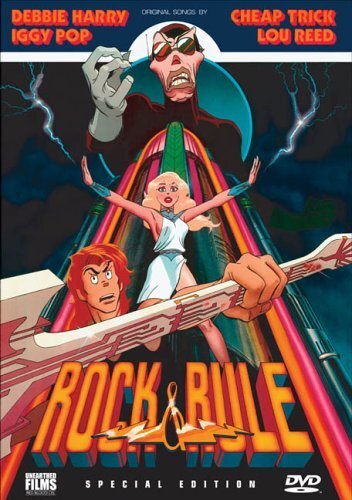 “Poppa!”
“Poppa!”We begin with a narrator explaining that this is the far future, after a world war wiped out human life and the mutated descendants of dogs, cats and rats created a new society. Which is a pretty unnecessarily bleak set up to a fairly standard funny talking animal world. This is not actually considered standard practice for the genre.
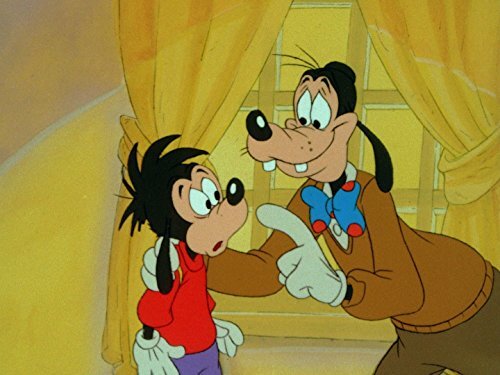 “Gawrsh Max, did I ever tell you about how the Old Ones burned the world?”
“Gawrsh Max, did I ever tell you about how the Old Ones burned the world?”Anyway, the narrator tells us that Mok, a legendary “super-rocker” has returned to Ohmtown, to work on his latest artistic project; deciphering an ancient code that will unlock a portal to another dimension and unleash a demon that will destroy the world.
 How Ozzy met Sharon, oddly enough.
How Ozzy met Sharon, oddly enough.To do this, he needs a special singer capable of really hitting those high notes and who preferable doesn’t have a competent agent.
We now meet our heroes, Omar, Dizzy and Stretch, three chipmunk looking critters who have a small rock band (whose name we never actually learn) and who are preparing to perform at open mike night in their local dive bar. They’re nervous as hell, so Omar busies himself with practicing guitar while Dizzy tries to distract himself with some hypnotic arcade games.

 “I’m not saying it. I’m not your performing monkey.”
“I’m not saying it. I’m not your performing monkey.”Rounding out the band is keyboardist Angel, voiced by Susan Roman for speaking and Debbie Harry for vocals. This character has a massive and passionate online fandom.

I don’t actually know that. I haven’t done any research to confirm that. But you know what? I’m gonna go out on a limb and say she does. Let’s just say, after ten years of blogging about animation, you start to develop an intuition. Anyway, Angel is not happy because the band is only going to get to perform one song and it’s going to be one of Omar’s. She manages to inveigle a promise out of him that, if they do get the chance to perform a second song, it’ll be one of hers. They get onstage and perform “Born to Raise Hell” by Cheap Trick but the song gets cut short when the manager decides they’re just that bad and drops the curtain halfway through. They’re like the musical equivalent of Heil Honey, I’m home!
Omar is able to trick the manager into giving them another shot through the cunning ruse of threatening to beat him to death with his guitar. Omar tries to play “Born to Raise Hell” but Angel goes rogue and starts singing “Angel’s Song”. Omar is so pissed off by this that he storms offstage but the rest of the band keep performing.
So let’s talk about the animation, which gets an absolute A for effort if not necessarily for execution. Regular commenter Lupin the 8th made the point that the movie seems OVER-animated at times which saves me the effort of having to say that thing. Every single detail of these characters is constantly in motion, to the point where it almost looks rotoscoped. The animators also have a habit of animating Mok’s lips so much that they look like an entirely seperate organism to the rest of his face. But balancing that, there are just some beautiful pieces of animation here. For example, there’s a bit when Omar storms offstage and Stretch, the drummer, gives Angel a sad little sympathetic shrug while he continues to play. And it is such a small gesture, but it is done so subtly and so gracefully and it is perfectly rendered.
After the show, the owner, Mylar, tells them that Mok was in the audience and that he wants the band to come and visit him in his Rock and Roll Doom Fortress. Angel is still furious at Omar for walking off mid performance so he goes and apologises and tells her she was good. This scene is pretty great. Omar is a good guy but he’s a young artist grappling with frustrated ambition, massive ego and equally massive feelings of inadequacy. He knows he fucked up but he lacks the eloquence and maturity to properly articulate why he did that he did. But Angel forgives him because she knows him well enough to understand what he means, and also because she’s in the same boat, grappling with that same frustration, ego and self-doubt. As they reconcile, it almost looks like they’re going to kiss but instead they just walk home in each other’s arms. It’s just…a really sweet, well observed little bit of character work. Good job movie.

So the gang head up to Mok’s creepy mansion where they meet his weird assistants, three massive triplets named Toad, Sleazy and Zip.
 If I said they were like a trio of mini-bosses from an early Amiga platformer, how many of you would even know what the fuck I was talking about?
If I said they were like a trio of mini-bosses from an early Amiga platformer, how many of you would even know what the fuck I was talking about?Omar, almost gets into a fight with one of the triplets but suddenly they’re interrupted by the arrival of Mok, who teleports right into their midst. Mok is voiced by Don Francks, but apparently one of the studios earlier idea for casting was Tim Curry. And…yeah, I totally see what they were going for.
 “How’d you do I, see you’ve met my, faithful HANDy man…”
“How’d you do I, see you’ve met my, faithful HANDy man…”Mok takes Angel out to the garden while Omar and Dizzy are distracted with electronic hallucinogens called “Edison Balls”.
 One of Nikolai Tesla’s most impressive inventions, to be sure.
One of Nikolai Tesla’s most impressive inventions, to be sure.But Stretch knows that winners don’t do glowing spheres and sneaks away, looking for Angel.
In the garden, Mok tempts Angel with fame and fortune, using holograms to mess with her head which results in some quite beautiful, trippy visuals.

But Angel refuses to abandon Omar and the rest of the band so Mok abducts her and takes off in his floating zeppelin supervillain lair (course, this movie was made in the eighties where record sales were high enough for artists to afford zeppelin lairs. Fuckin’ Spotify, man.)
Waking up from being “totally stoned” (the movie’s words, not mine) Omar and Dizzy are shocked to learn that Angel left with Mok. But Stretch is convinced she was taken against her will so the band follow the blimp to “Nuke York”, where Mok is planning his concert to open a doorway to another dimension. Imprisoned in Mok’s skyscraper in Nuke York, Angel meets Cindy, who’s the sister of the triplet henchmen. Thinking that Angel is just one of Mok’s groupies, Cindy helps her escape the the tower through the air ducts. On their way out, Angel hears Mok discussing his plan to unleash a demon on the world to punish it for not appreciating his musical genius. He asks his computer if the demon can be stopped and the computer replies that the only way is “one voice, one heart, one song”. Mok asks who can do that, and the computer replies “no one”. Did you notice the computer didn’t reply “no two”? So did I. I wonder if that will be relevant. Yes, obviously we can all see where this is headed.
 “What was it the poet Keats said, Jeeves?”
“What was it the poet Keats said, Jeeves?” “Two minds, with but a single thought, two hearts that beat as one, sir.”
“Two minds, with but a single thought, two hearts that beat as one, sir.”Now, this is where the lack of a script starts to show. There’s a lot of shuffling back and forth between locations, a lot of set pieces that look like they were made more because the animators thought they’d be cool to draw rather than because they have a concrete narrative purpose. The band visit Stretch’s aunt, who’s a tattoo artist and gives them a lead on Cindy, because she gave her a tattoo recently. Dizzy and Stretch go to a club where Cindy usually hangs out and where she’s brought Angel. They search for Angel while the animators show us what the Pink Elephant Parade from Dumbo would have been like if the influence of drugs had been explicit rather than merely heavily implied. Meanwhile, Omar tries to break into Mok’s lair and finds Mok and Angel cooing lovingly at each other, which causes Omar to undergo a full, Wiseau-level breakdown.
 “You ah tearing me ahpart, Angel!”
“You ah tearing me ahpart, Angel!”It turns out that this “Angel” is just a lookalike, however. The real Angel is captured and brought back to Mok’s lair where she refuses to sing for him. He shows her a massive Edison Ball where Omar, Stretch and Dizzy are being tortured and she surrenders. Omar, Dizzy and Stretch’s brains have been reduced to a fine paste by the Edison Ball, so Mok sticks them on a bus headed for Ohm town and gets ready for his big concert. Unfortunately, opening a dimensional portal takes a lot of juice and the concert is a disaster after Mok causes a black out. He decides to hold the next concert in Ohmtown because it has a big ass power plant (“OHMtown” I just got that.
The boys have recovered from their brain-pasting and Stretch sees a poster advertising the concert. He tries to get Omar to help him mount a rescue but Omar’s still heartbroken from seeing Angel with Mok. Stretch is all “dude, that was OBVIOUSLY just a mutant in a perfectly lifelike Angel mask designed to fuck with your head” but Omar finds this unconvincing. Stretch and Dizzy race off to the concert but are too late to stop Mok summoning the demon.
 “Plaaaaaaaaay me the best sooooong in the world! Or I’ll eat your souls.”
“Plaaaaaaaaay me the best sooooong in the world! Or I’ll eat your souls.”Zip dies protecting Angel from the demon. Suddenly Omar appears and frees her. She tries to banish the demon but can’t do it alone, so Omar and Angel sing together because obviously that’s what this was all leading up to. Sleazy, furious at Mok for his brother’s death, picks the rocker up and flings him into the fiery portal.
And the movie ends with the band performing together, as a new superstar rock band. Which, if history is any judge, will make them very, very happy.
***
Scoring
Animation: 15/20
By no means flawless but always visually distinctive, frequently beautiful and bursting with enthusiasm and heart.
Leads: 14/20
The movie manages the rare trick of having an unlikeable protagonist whose flaws make him compelling and believable rather than an insufferable jerk. And for a female lead in an eighties animated film, Angel is a pretty well rounded character.
Villain: 15/20
Interesting design, great vocal performance.
Supporting Characters: 11/20
I like Stretch. Dizzy is kinda insufferable.
Music: 13/20
Notoriously, the audio mixing in this movie (at least on some versions and certainly the one I watched) is awful. There’s some pretty rockin’ tracks here, but be warned that if you listen to hard rock and actually like being able to hear the lyrics, you’re gonna have a bad time.
FINAL SCORE: 68%
NEXT UPDATE: 24 November 2022
NEXT TIME: Okay everyone. Huff some cat pee, and I’ll see you on the other side…
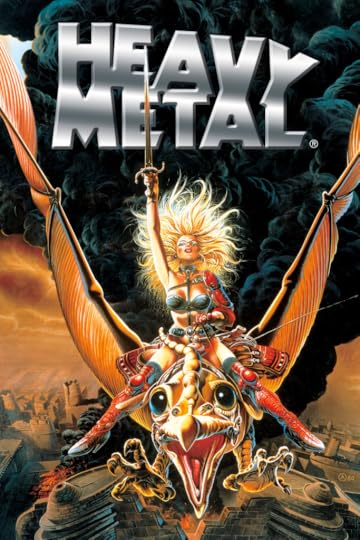
October 30, 2022
Devilman Crybaby (2018)
If you’ve spent any time reading about animé you will have come across the name “Osamu Tezuka”, almost certainly accompanied by the phrase “Godfather of animé/manga”. And that’s true, as far as it goes. Tezuka absolutely kickstarted post-war animé as a genre. But…it kinda feels like we’re missing something, doesn’t it? How exactly did we get from this:
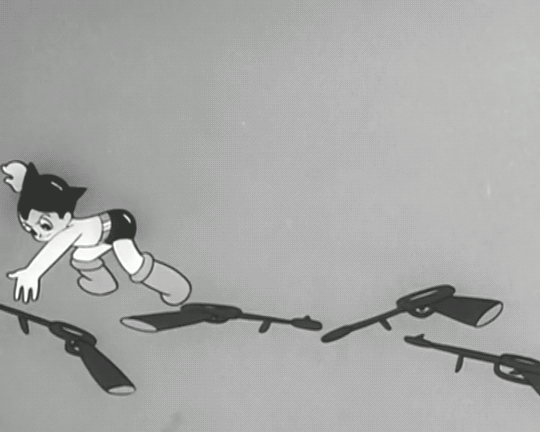
To THIS:
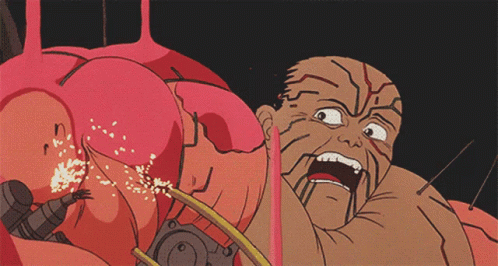
Well to understand that we need to talk about the other godfather of manga and animé. For Osamu Tezuka created animé as a beautiful, innocent garden. But into that garden, there came a serpent. There came Go Nagai.

Hired as a writer and illustrator for Weekly Shonen Jump in 1968, Nagai became an instant cultural lightning rod and enfant terrible of manga with his series Harenchi Gakuen. An erotic comedy set in a school, the series attracted massive controversy in Japan (damn prudes!) with its boundary smashing depictions of nudity and sexuality in a comic ostensibly aimed at children (sometimes have a point!). Nagai’s entire career has been one long game of seeing what he can get away with. His work is categorised by coarse humour, extreme violence, body horror and a pessimism often bordering on nihilism.
 “What’s nihilism?”
“What’s nihilism?” “Doesn’t matter.”
“Doesn’t matter.”Also, Nagai is notorious for a, shall we say, somewhat cavalier attitude to the ethics of depicting sexual assault against women. To put it another way, much of his work is rapier than a full orchestral production of Blurred Lines at the Global Fencing Championships. Shit. Gets. Messed. Up. And his influence cannot be overstated. If you’ve ever watched some disreputable animé late at night and found yourself wondering…why?
Go Nagai. Go Nagai is why.
Go Nagai is why so much of animé is so violent, so weirdly horny and frequently so goddamned awesome. It’s a…complex legacy, to be sure. And much of Nagai’s work is definitely not for me. But he also blazed a trail that was followed by many of the most important and respected creators in the medium, like Katsuhiro Otome and even (I would argue) Miyazaki.
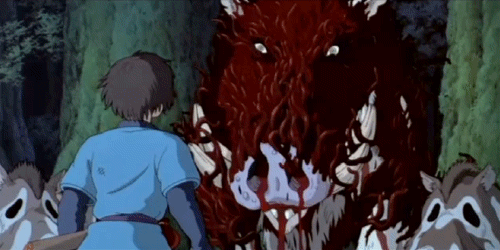
Now, the most important part of Nagai’s oeuvre is the massive Devilman franchise, a constellation of manga, animé adaptations, remakes and spin-offs. There’s a lot of overlap and differences between the various iterations but it usually goes like this; Akira Fudo is an ordinary Japanese schoolkid who gets recruited (or sometimes just duped) by his childhood friend Ryo Asuka into a war to protect humankind from demons. In order to do this, Ryo has Akira become possessed by an ancient warrior demon named Amon to fight other demons. Akira then becomes a superhero named “Devilman” (pronounced “DEEEEEEVILMAAAAAAAAAAAAAANNN!!!!”). From there, the story usually proceeds through a few monster of the week episodes with certain series-standard demons appearing to get the every-loving demonic shit kicked out of them before taking a sharp left turn with humanity becoming aware of the existence of demons whereupon things get fucking dark.
Very violent. Very horny. Not for everyone. Go Nagai.
Now, there have been several animé adaptations of the original 1972 manga. There was the ridiculously toned down seventies Toei series which was kinda like if The Human Centipede was remade as a Saturday Morning Cartoon about a bunch of people who change into a giant centipede to fight baddies through the power of friendship. Then there was the far more faithful (and pretty damn kickass) OVA in the eighties, a couple of other OVAs in the nineties and early aughts and finally the subject of today’s review Devilman Crybaby, a mini series created by Science SARU for Netflix. Now, one of the reasons I pushed this review back to Halloween (other than just to have a horror themed review for Halloween) was that I knew nothing about this franchise and had a suspicion I would need the extra prep time. And I’m glad I did. Devilman Crybaby was an absolute juggernaut when it was released, becoming one of the most watched and successful animé series in years with a rabid fanbase. The kind of thing you really need to research and read up on before you come out with something like “I watched it and I didn’t really care for it”.
Anyway. I watched it.

Obligatory “no I’m not doing a point by point recap of ten episodes of intricately plotted animé”. I’m just going to make some broad strokes observations.
Okay, my first big, pretty much insurmountable problem is the animation. Particularly in any scene with the demons. With a few exceptions the demons in Crybaby just look like absolute dogshit. Crudely animated and unimaginatively designed.
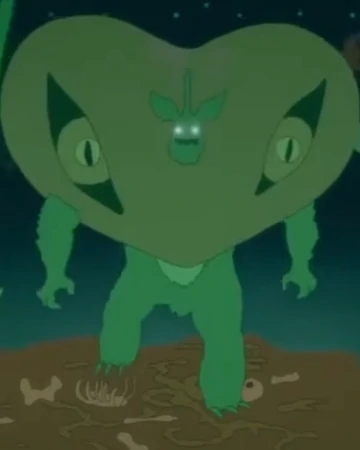
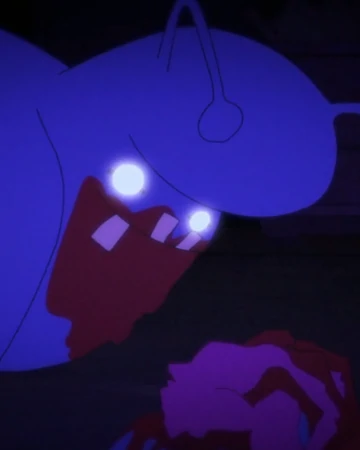

For fuck’s sake, Adventure Time, a show with a deliberately simple and cutesy art-style, has scarier, more detailed demons.

 “BASTARD!”
“BASTARD!” “OTAKU OCEANIA! YOU DARE CHALLENGE ME!?”
“OTAKU OCEANIA! YOU DARE CHALLENGE ME!?” “I WILL DEFEND THIS GLORIOUS ANIMÉ! I CHOOSE “IT’S A STYLISTIC CHOICE” ATTACK HYAA!!!”
“I WILL DEFEND THIS GLORIOUS ANIMÉ! I CHOOSE “IT’S A STYLISTIC CHOICE” ATTACK HYAA!!!” “YOU FOOL! THAT ATTACK HAS NO POWER AGAINST ME!”
“YOU FOOL! THAT ATTACK HAS NO POWER AGAINST ME!” “HUH?!?!”
“HUH?!?!”I always find the argument “we did it this way deliberately as an artistic choice and it just coincidentally happens to be cheaper and easier to animate” to be less than convincing. But sure, it’s absolutely possible that this was a deliberate choice. Actually, the fact that the demon scenes are so much worse than the rest of the series animation-wise lends credence to that. But here’s the thing, even if it was a deliberate choice? Sometimes choices are bad.
Deliberately making an unfunny sitcom? Bad choice. Casting Mark Wahlberg as a scientist? Bad choice. And making an adaptation of a series famous for body horror and skimping on the detail? Bad choice. There are many horror sub-genres that benefit from a “less is more” approach. Body horror is not one of them. Body horror demands detail. With body horror, it’s go moist, squishy and disgustingly explicit or go home. Compare the designs above with these designs from the 1987 OVA.





Here is the demon turtle Jinmen in the eighties OVA:
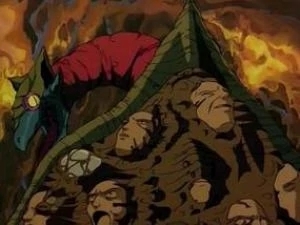
And here he is in Crybaby:
 Wow, it’s almost dark enough to hide the complete lack of effort.
Wow, it’s almost dark enough to hide the complete lack of effort.I’m sorry, one of these creative teams is clearly earning their paycheck and it ain’t “the greatest animé of 2018”. Okay, well what about the rest of it? The human-centric scenes, those are great, right?
Ehhhh…
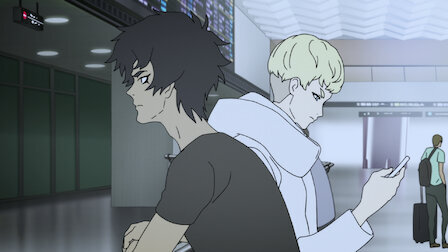
It’s definitely not as flat-out bad (in my opinion) as the demon stuff but I’d be lying if I said I liked this. There’s next to no variation in line thickness on the models and they come across as kinda flat. I get very little sense of weight and solidity when these characters move. More a personal thing, but sorry, I just don’t jive with this show’s animation in general.
Okay, well, to hell with the aesthetics. A good story’s a good story as long as the writing is…
 “THE WRITING IS BAD!”
“THE WRITING IS BAD!” “AAARGH! SNEAK ATTACK!.”
“AAARGH! SNEAK ATTACK!.”Alright, let me be fair.
The dialogue (in the English dub at least) is mostly portentous and overly expository when it is not being aggressively dumb. Ryo has a line where he claims that humanity is weaker than the “vast majority of the animal kingdom”. And it’s not immediately followed by someone smacking him upside the head for saying something so OBVIOUSLY AND DEMONSTRABLY FALSE.
However, the Japanese subbed version is MUCH better in this regard (and, honestly, the performances are lightyears ahead too).
But there is still an overarching issue with both versions in that they have a real problem with portraying believable human beings. Look, there are plenty of awful protagonists out there. Cersei Lannister, Walter White, Tony Soprano. But audiences find these people compelling because their actions, while deplorable, stem from motivations that are understandable and, more importantly, clear. It’s fine to have a main character do awful shit, as long as the audience finds it perfectly comprehensible why that awful shit is being done. Devilman Crybaby has a real problem with this. Sometimes it comes from being overly faithful to the source material. For example, the first time Ryo sees Akira since their childhood, Akira is being hassled by some bullies. Ryo then opens fire with a frickin’ machine gun and Akira gets in the car with him and they drive off. Later, Akira is possessed by a demon after Ryo used him as bait and he isn’t angry or upset at this betrayal in any way. Now, both of these elements were present in the original manga…and they were screwy there too. Interestingly, both these points were changed in the eighties OVA (okay, I’ll shut up about it now but it’s up on YouTube and you really should check it out).
Or take this scene for example:

Very famous image. Probably the most iconic shot of this whole series. But here’s what’s happening in this scene. Ryo and Akira have broken into the penthouse of a skeezy photographer who is actually a water demon to rescue Miki, the daughter of the couple that Akira is living with and Akira’s love interest. Akira saves Miki and is holding her unconscious (and naked, obviously) body when Ryo pulls a gun and says that he has to shoot Miki because she knows too much. So Akira charges directly at Ryo while holding Miki’s body and headbutts Ryo so that both their heads start bleeding. And they just growl at each other, with Ryo not doing anything even though he could literally just shoot Miki because Akira brought her into point blank range.
Sure, it’s metal as fuck but these characters’ actions don’t have any correlation to their goals as understood by the audience. Akira doesn’t want Ryo to shoot Miki, so why would he bring her closer to him? Ryo wants to shoot Miki, and very easily could, but he doesn’t.
This all speaks to a larger problem with the series. These characters don’t act consistently and believably, so it’s hard for me to empathise with them as anything other than fictional constructs. Why do Akira and Ryo butt heads until they bleed? Because they’re cartoon characters and it looks badass.
 “IT’S SYMBOLISM!”
“IT’S SYMBOLISM!” “YES! BADLY DEPLOYED AND TO THE DETRIMENT OF THE WORK!”
“YES! BADLY DEPLOYED AND TO THE DETRIMENT OF THE WORK!”And this becomes a big problem later on when we get to the “shit gets fucking dark” portion of the story. And look, I don’t want to spoil it but…well, let’s just say Devilman Crybaby lives up to the standards for dark horror that this franchise prides itself on. I mean to be honest, it kinda smashes it. Virtually every named character suffers some unbelievably messed up shit. And you know what I felt?
Nothing.
I did not care for these characters in the slightest and when the time came for them to meet their ultimate fates it just felt cheap and ugly and try hard. I just wanted the whole thing over with.
So. Okay, I gotta have some positives, right? Sure I do.
I like the new Devilman design.
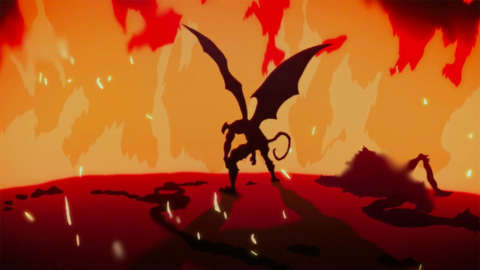
I like how lithe and lanky it is, it’s cool.
Some of the ways the animé updates the story is very clever. It puts a focus on social media and how it turns us into metaphorical and (in the cartoon) literal demons. The idea that human beings knowing for a fact that demons were real would be more dangerous and destructive than humans would ever be? That stuff works very well. The final few episodes do succeed in generating a real sense of escalating menace as the world starts to tear itself apart through paranoia and hatred. I got serious Second Renaissance vibes and I don’t say that lightly.
But, even during those high points, I was still thinking “Man. This looks like ass.”
So unfortunately, that’s my final thought on the matter.
Devilman Crybaby. It looks like ass.
 “This isn’t over, Mouse.”
“This isn’t over, Mouse.” “Aw crap. Honey? If I go missing suddenly I was assassinated by weebs.”
“Aw crap. Honey? If I go missing suddenly I was assassinated by weebs.”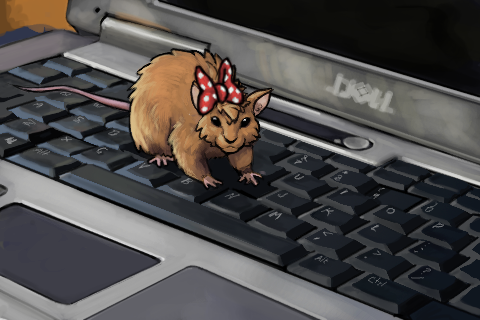 “Okay, want me to lie and tell people you died in a less embarrassing way?”
“Okay, want me to lie and tell people you died in a less embarrassing way?” “Thank you, boo.”
“Thank you, boo.”Scoring
Animation: 07/20
Varies wildly from “not my cup of tea” to “who shit in this cup of tea”?
Leads: 06/20
What an odd young man.
Villain: 07/20
Man, I was so invested in his devious scheme to apparently TALK THE WORLD TO DEATH.
Supporting Characters: 04/20
It’s all so so tragic.
Music: 16/20
Oh, I found something else to be positive about. The music by Kensuke Ushio. Is. The. Frickin’. Tops.
Listen to this. Wait for the drop.
Get a mop.
FINAL SCORE: 40%
NEXT UPDATE: 11 November 2022
NEXT TIME: Come and see what happened when the Chipmunks hit their hair metal phase as we kick off NOVEMBER, THE MONTH OF ROCK!!
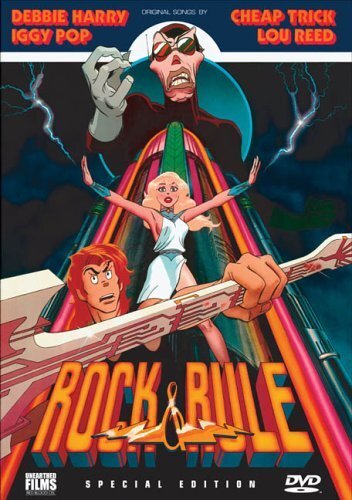
October 12, 2022
Sailor Moon R: The Movie
This is one of those reviews where I feel like literally every single person interested enough to read it already knows far, far more about the topic than I do and is just waiting for me to make a massive ass of myself. I never watched Sailor Moon growing up and was only vaguely aware of it as the animé that most people think of when they hear the word “animé”. So I went on a rather fascinating tvtropes binge (did you know that the entire Japanese magical girl genre was inspired by the American sitcom Bewitched?) and I’m proud to report that I’ve gone from being absolutely clueless to loveably befuddled in record time.
Okay. So. Let’s start at the end and work our way backwards.
What is Sailor Moon R: The Movie?
Sailor Moon R is a movie based on Sailor Moon R.
What is Sailor Moon R?
Sailor Moon R is the second season of the Sailor Moon animé.
What is the Sailor Moon animé?
The animé adaptation of Naoko Takeuchi’s manga about schoolgirl Usagi Tsukino who discovers that she is the reincarnation of an ancient warrior princess from a kingdom on the Moon. As Sailor Moon she battles evil monsters with the help of other girls/reincarnated warriors such as Sailor Mars, Sailor Venus, Sailor Mercury and Sailor Jupiter. It’s a fusion of the magical girl genre with the sentai superhero genre.
What is best in life?
To crush your enemies, to see them driven before you and to hear the lamentation of the women.
Why don’t girls like me?
Because you’re not actually a person, you’re just a rhetorical device I’m using for this review.
What? Wait come back!
We begin on the roof of a psychiatric hospital where two young boys are talking. One of the boys, whose name is Mamoru Chiba, hands the other a rose. The other boy vanishes, but promises that he’ll return with a flower for Mamoru.
In the present, Mamoru is a teenager and is visiting the local botanical gardens with Usagi and the other sailors. Alright, so let’s fill in a little backstory here. Mamoru was a recurring character in the series who was just this guy that Usagi didn’t have a lot of time for.

No, Usagi only had eyes for Tuxedo Mask, a dashing mysterious superhero who would always show up and help her in the nick of time.

Yeah, you can probably guess how that particular plot thread was resolved. So this movie is set some eighty episodes into the animé’s run and Mamoru has unmasked and is dating Usagi. They find themselves alone and Usagi tries to steal a smooch while the other sailors spy on them like a bunch of pervs. With the sailors is Chibiusa, a small pink haired child who is very jealous of Usagi trying to kiss “my Mamo” which is super weird because Usagi and Mamoru are her parents in the future or something, I dunno guys, it’s a weird show.
Anyway, Mamoru’s drama sense starts tingling and he leaves Usagi mid-pucker to go outside. There, he finds an extremely sexy young man.
 Or possibly your friend’s cool mom.
Or possibly your friend’s cool mom.This tall drink of water apologises to Mamoru for taking so long but says he finally found the perfect flower for him. He then takes Mamoru’s hands in his in just the straightest way.
 “Boys…holding hands…with boys?!”
“Boys…holding hands…with boys?!”Usagi and the other girls see this and Usagi rather politely but firmly tells the newcomer to “step off, skank” and the stranger knocks her to the ground. Fioré (for ’tis his name) tells Mamoru that he will fulfil his promise to him and then leaves in the traditional manner of spurned ex-boyfriends, vanishing into the sky in a flurry of rose petals.
The sailors return to Hikawa Shrine which essentially functions like their Batcave and their talking cats (they have talking cats) named Artemis and Luna tell them that a big asteroid is headed towards Earth. The asteroid isn’t expected to strike Earth, but the cats are worried because the rock is giving off “strange plant” energy. The sailors quickly derail the meeting though by speculating on Mamoru and Fiore’s relationship. Because this is the 2014 Viz English dub and not the original Optimum dub from the 2000s, this means actually acknowledging that Fiore and Mamoru might have had a romantic relationship. I mean, no one actually says “dem boys fuckin'” but from context its unambiguous that that’s what they’re talking about. Unlike in the original dub where Fiore and Mamoru are just good friends.
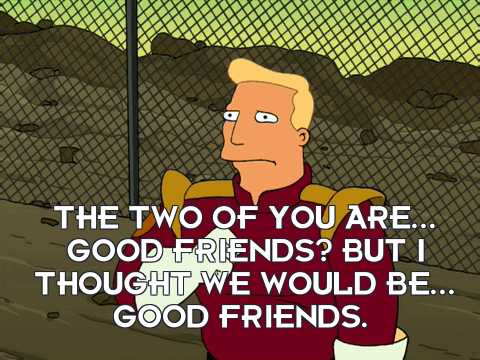
The next day, the sailors mosey into town and are attacked by ordinary Tokyoites who have been turned into zombies by mysterious vines. The sailors defeat the zombies and Sailor Mercury traces the attack to a single innocuous looking flower.
 “HA! IT WAS I, YOU FOOLS!!”
“HA! IT WAS I, YOU FOOLS!!”The flower turns into an evil sexy flower lady called Glycina and the sailors transform to battle her. I…kinda feel like bringing up the fact that the transformations are ludicrously over-sexualised is beating a dead horse at this point. It’s one of the things the show is most famous/notorious for and I don’t really have anything more to add other than “yup, that is “child beauty pageant” levels of uncomfortable”.
Anyway, the flower captures Mars, Venus, Mercury and Jupiter in her vines and starts draining their energy. But they’re rescued at the last moment by Sailor Moon who cuts through the vines yelling: “The life of a flower is too short! That’s why girls should fall in love while they can!” which is just a great message for this movie’s fanbase god DAMN. Anyway, they defeat Glycina but Fioré shows up and reveals that this was just an experiment to see if his flower could survive on Earth. Fioré reveals his true form, which is much more “David Bowie in Labyrinth“.
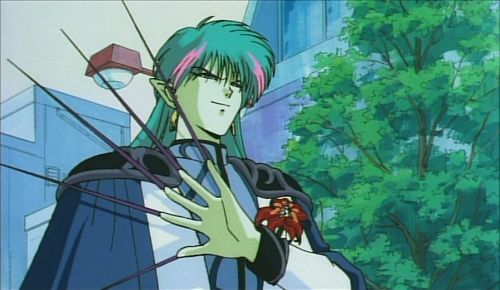 “You remind me of the babe.”
“You remind me of the babe.”Fioré is wearing a flower that Artemis and Luna identify as a Kisenian and which is clearly mind controlling the poor lovesick putz. Fioré attacks Sailor Moon but is stopped by the sudden arrival of Tuxedo Mask, most dapper of all superheroes. Fioré is delighted because he instantly recognises that Tuxedo Mask is Mamoru. Something that, I hasten to add, Sailor Moon only figured out after EIGHTY ONE EPISODES. AFTER HE TOLD HER.
 No no. You definitely made the right choice, bud.
No no. You definitely made the right choice, bud.Fioré decides that his beloved Mamoru has been enmeshed in the wiles of a diabolical intellect of unfathomable depth and tries to kill Sailor Moon. Mamoru takes the hit and lies dying in Sailor Moon’s arms. Horrified by what he’s done, Fioré whisks him away to his base on the asteroid and stores him in a magical crystal so he can heal and to give good old Stockholm Syndrome a chance to work its magic.
We learn more about Fioré and Mamoru’s past. Fioré was wandering through space when he fell to Earth, exhausted. Mamoru, who had just been orphaned in a car crash, took care of Fioré. But Fioré couldn’t stay on Earth because of the atmosphere so he had to return to space. Tearfully, Mamoru gave him a rose as a parting gift and Fioré was so touched he decided to scour the galaxy to find the perfect flower to give him in return. Then he found the Kisenian flower which suggested that Fioré should wipe out all of humanity for leaving Mamoru alone and sad and Mamoru’s all “whoah, no, you completely misread me on that one”. Fioré then tells Mamoru that “no one’s allowed give you flowers except me”.
 “You see, “flowers” are a metaphor for…”
“You see, “flowers” are a metaphor for…” “Your dick. Yeah. I got it.”
Back on Earth, the sailors plan to teleport to the asteroid to rescue Mamoru and save the Earth but Sailor Moon doesn’t want to go because she doesn’t want to put the other sailors in danger. Of course, if they don’t go, the whole planet’s doomed anyway so…guys I’m starting to worry this girl just ain’t that bright. Anyway, Chibiusa tells her to buck up and get back out there and give one more for the gipper and rescue her future Dad.
The sailors travel to the asteroid and battle an entire army of flower monsters. They fight them off but the Fioré appears and captures Mercury, Jupiter, Venus and Mars. The other sailors yell at Sailor Moon to keep fighting to save the Earth but Fioré tells her to surrender or he’ll kill her friends and she’s all…
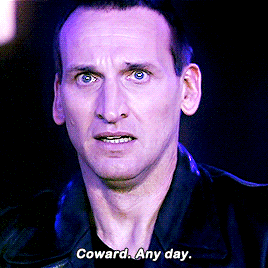
…and drops her wand. Fioré begins drains Sailor Moon’s energy but before he can kill her, the other sailors beg for her life, saying that without her each one of them would be alone. This just further convinces Fioré that Sailor Moon is a devious, manipulative home-wrecking skank who must be destroyed before she steals ALL the boyfriends in the universe but just before he can land the killing blow Mamoru breaks free and throws his rose into Fioré’s heart. This (somehow) causes all the flowers on the asteroid to die but also causes the asteroid to change course and it’s now headed for an impact so, y’know, swings and roundabouts.
Sailor Moon decides to use the Silver Crystal, an immensely powerful magical artifact to change the course of the asteroid which will probably kill her. Fioré attacks her and touches the crystal, which causes him to see a memory which reveals that it was actually Usagi who gave Mamoru the rose in the first place that he then gifted in turn to Fioré.
 “My God! It was her dick all the time!”
“My God! It was her dick all the time!”Realising that he’s been just a Grade A chump, Fioré allows himself and the last Kisenian flower to be vaporised. As the asteroid enters Earth’s atmosphere, the sailors combine their powers. It’s the power of friendship versus gravity and, not surprisingly, they make gravity their bitch.
They succeed in redirecting the asteroid but they’ve paid a terrible price; Usagi is dead. But, the ghost of Fioré appears before Mamoru and gives him a flower. He says that this flower contains the last of his life energy and that he most draw the nectar out with his mouth and then kiss Usagi.
 “See, the nectar represents my…”
“See, the nectar represents my…” “DUDE I GET IT.”
He kisses her, she comes back to life, she decides not to ask what that weirdly familiar taste in her mouth is I am skirting on reeeeeal thin ice with this whole review everyone’s happy let’s just end it there.
***
It’s weird to feel nostalgic for a show that you never watched as a kid but I gotta say, I really liked this. It hits that real sweet spot of being good enough to enjoy unironically while being deliciously, hilariously “nineties animé”. This actually made me genuinely sad that, as a 39 year old man, I almost certainly can’t start ordering DVD boxsets of the show and trade paperbacks of the manga without getting put on a watchlist.
Scoring
Animation: 06/20
So, there’s clearly been a bump in the animation budget from the TV show and the action now has a pleasant zip and fluidity to it. It’s hardly top tier though and the character models are often painfully generic, to the point where it can be difficult to tell characters apart. I mean, look at this picture of Sailor Moon…

…which is actually a picture of Sailor Venus which you didn’t even notice thereby proving my point.
Lead: 10/20
I like that Usagi is an unapologetically feminine girly girl who nonetheless wrecks shop on a cosmic scale.
Villain: 08/20
Look, who HASN’T turned into a world-threatening supervillain after a bad breakup?
Supporting Characters: 12/20
The Sailors make for a great team of contrasting archetypes. Smart one, nice one, tough one and…um…weird psychic one. Re-inventing the wheel? No, but good, solid fundamentals.
Music: 11/20
Light, breezy little J-pop numbers for them who wants ’em.
FINAL SCORE: 47%
NEXT UPDATE: 31 October 2022
NEXT TIME:

October 6, 2022
German Cover Reveal for When the Sparrow Falls!
Sprechen sie Deutsch? Nein? Well get on that!
I’m delighted to FINALLY be able to reveal that When the Sparrow Falls is being published in a German language edition by Piper Verlag.
The German edition will be released in April 2023 under the title Ecce Machina: Die Seele der Maschine and is available for pre-order HERE.
And now, feast your eyes on this gorgeous cover!
 Keen readers will recognise this cover as depicting the scene where Johnny and Millicent Sparrow realise they have to put aside their differences if they’re ever going to save the orphanage. I was very proud of that scene.
Keen readers will recognise this cover as depicting the scene where Johnny and Millicent Sparrow realise they have to put aside their differences if they’re ever going to save the orphanage. I was very proud of that scene.



